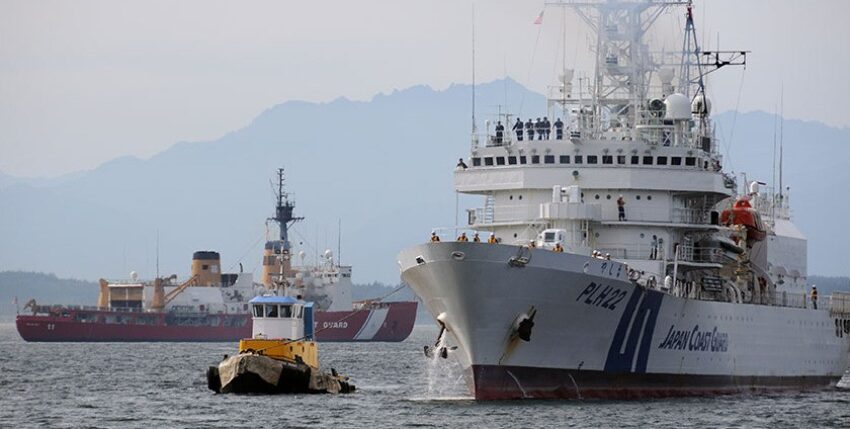As a major economic power, Japan maintains an extremely efficient coastguard with a wide range of tasks and capabilities in addition to its navy. Together, they ensure security in a conflict-prone region of the world.
With over 6800 islands (of which more than 400 are permanently inhabited) and a coastline of 29,751 kilometres, Japan is one of the largest maritime nations. In addition to the four large main islands, smaller island groups such as the Ogasawara and Ryukyu Islands ensure that Japan, with a land area of 380,000 square kilometres, has almost as large territorial waters (430,000 km2) and an Exclusive Economic Zone (EEZ) of more than ten times its land area. In view of Japan's dependence on imports of raw materials, exports of goods and fishing rights, the island nation therefore relies not only on a strong navy (Japan Maritime Self-Defence Force, JMSDF), but also on one of the largest coast guards in the world, the Japan Coast Guard (JCG).
The JCG can look back on over seventy years of history. In the chaotic years following the Second World War, the American occupying power recognised early on the need for reliable coastal protection around Japan, which was struggling with illegal immigration, piracy, smuggling and leftover World War II mines. After an Illegal Immigration Control Headquarters had already been installed in 1946, the Americans therefore initiated the establishment of the Maritime Security Agency (MSA) in 1948, which from then on was responsible for coastal defence as part of the Ministry of Transport.
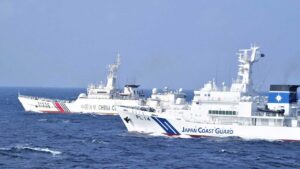
of a CCG patrol vessel, photo: JCG
The Coastal Safety Force, which was established within the MSA in 1952, brought together the MSA's mine defence forces and the now increasing number of larger ship units from the USA and was merged into the JMSDF on 1 July 1954 - a reaction to the East-West conflict, which was also becoming increasingly noticeable in the Far East, fuelled by the Communist takeover in China in 1949 and the Korean War from 1950 to 1953. The MSA itself now concentrated on the tasks of a traditional coastguard. In April 2000, the MSA was renamed the Japan Coast Guard, but remained under the successor authority of the Ministry of Transport.
Growing range of tasks
Shortly after the JCG was given its new name, its range of tasks was significantly expanded in April 2001. Whereas in the years before the turn of the millennium, the JCG's main tasks were the general maintenance of maritime security in coastal waters, sea rescue operations and disasters as well as marine research and environmental protection, the focus now shifted more strongly to securing territorial waters and the EEZ. Tasks relating to combating terrorism, monitoring foreign fishing, research and patrol boats, defence against illegal immigration and smuggling were also expanded or completely redefined in the course of the reforms. From then on, the JCG blossomed into a secret "second navy" alongside the JMSDF.
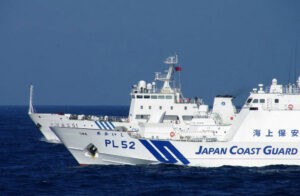
Coast guard vessel near the Senkaku Islands, Photo: JCG
On 22 December 2001, there was an armed clash between units of the Japanese Coast Guard and a North Korean spy ship within the Japanese EEZ near the island of Amami-Oshima in the East China Sea. After a six-hour firefight, the North Korean ship sank following several explosions, but was later salvaged by the JCG and has since been on display at the Japanese Coast Guard Museum in Yokohama. Two years earlier, the JCG had had to call on the JMSDF for assistance in a similar incident near the Noto Peninsula. The incident near Amami-Oshima was by no means the first confrontation with North Korean spy ships, but it demonstrated Japan's determination to counter violations of its waters more resolutely and now rely more heavily on the JCG to do so.
The background to the 2001 reforms was, of course, not only North Korean espionage operations but also a strengthening Russia and a militarily more self-confident China, which was making its territorial claims in the East and South China Seas increasingly clear. In the twenty years since the expansion of the JCG's range of tasks, the smouldering conflict with China in particular has tied up enormous JCG forces in the vicinity of some island groups, which has made an increase in the Coast Guard's numbers unavoidable.
Scope and structure of the JCG
With around 14,300 personnel, 473 ships and boats and 85 aircraft, the JCG is one of the largest coast guards in the world. The headquarters in Kasumigakesi (Tokyo Prefecture) is subordinate to eleven regional headquarters, which are mainly concentrated in the south of the country. The floating and flying units of the JCG are also concentrated in the south of the country and have access to a large number of bases, some of which are used jointly with the JMSDF.
The floating units of the JCG comprise 140 patrol vessels, including 17 large units with up to two helicopters, which the JCG refers to as "patrol vessel, large, with helicopter" (PLH), as well as 49 large, 38 medium-sized and 36 smaller units. The largest patrol vessels have a displacement of between 6,000 and 9,300 tonnes, which is on a par with modern destroyers. However, the vast majority of patrol vessels are more reminiscent of typical offshore patrol vessels with displacements of between 700 and 2000 tonnes. In addition, the JCG has 238 small patrol boats as well as 68 small guard boats, 14 hydrographic survey vessels, six lighthouse tenders, three measuring boats for radioactive radiation, three training vessels and one large fire-fighting vessel.
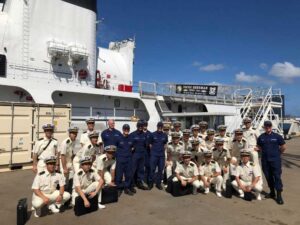
of the US Coast Guard in Hawaii, Photo: USCG
The JCG's 33 aircraft, including Beechcraft Super King Air, Bombardier Dash 8 and Dassault Falcon 2000, and 52 helicopters (including AugustaWestland AW 139, Bell 212 Twin Huey and Airbus Helicopters H 225) support the floating units or perform independent tasks in the transport and SAR sector as well as maritime surveillance, which is particularly important for Japan. In order to better monitor the vast sea areas around Japan, the JCG will also have Unmanned Aerial Vehicles (UAV) at its disposal in future; initial trials with the MQ-9B SeaGuardian were already carried out in 2020.
All in all, the JCG has experienced a noticeable quantitative and qualitative increase in recent years, reflecting its expanded range of tasks. For example, the number of vessels over 1000 tonnes has risen from 51 in 2012 to 63 eight years later, and the fleet is to be expanded in the future to include further large patrol vessels. By way of comparison, the US Coast Guard will only have 36 units of this size in the long term according to current planning.
The days when the JCG had to make do with decommissioned and disarmed units from the JMSDF are also long gone. The armament of the floating units corresponds to the usual standard of coast guards worldwide and, in the case of larger ships, usually consists of individual guns with calibres of up to 40 millimetres as well as machine guns for close range. In confrontations with foreign ships and boats, however, the JCG often resorts to water cannons, unless it succeeds in pushing away unwanted intruders through skilful manoeuvres.
Current challenges
For decades, disputes have repeatedly arisen between Japan and Russia over the Kuril Islands north of Japan's main islands, which are claimed by both sides, mostly over fishing rights and thus ultimately unresolved territorial issues from a Japanese perspective. The main task of the JCG vis-à-vis Russia is and remains the protection of Japanese fishing grounds from Russian fishing trawlers and the protection of Japanese fishermen from Russian naval and coastguard units. In recent years, Russian or Sino-Russian naval units have often practised demonstratively close to Japanese waters, sometimes even completely surrounding the main Japanese islands - a blatant demonstration of power by both nuclear powers, to which the Japanese coastguard is of course unable to respond effectively.
From the JCG's point of view, the situation with North Korea is even more complicated as, in addition to espionage activities, North Korean fishermen repeatedly attempt to escape, often getting into distress at sea; the abandoned boats then often drift onto the Japanese coast. In recent years, the JCG has resolutely countered North Korean fishing boats entering Japanese waters, usually using water cannons in addition to warning shots. An incident in June 2021, when Japanese Coast Guard units were able to identify portable SA-16 surface-to-air missiles on board a North Korean fishing boat, showed that the situation can take on threatening proportions. All in all, the tasks of the JCG with regard to North Korea are mainly characterised by the unpredictability of the North Korean side.
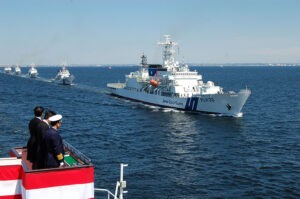
Anniversary of the JCG 2018, Photo: JCG
However, the main focus of the Japan Coast Guard has been on China for years, which has been able to increasingly emphasise the country's extensive territorial ambitions in the East and South China Seas thanks to its constantly growing naval forces and coast guard (Chinese Coast Guard, CCG). The uninhabited Senkaku Islands on the southern tip of the Ryukyu archipelago in particular have been the subject of a fierce dispute between the two states in recent years, which can look back on a long history and has been further fuelled by suspected raw material deposits around the archipelago.
From a Japanese perspective, the situation around the Senkaku Islands is complicated in several ways. The archipelago is administered by the municipality of Ishigaki, which is a good 170 kilometres away and part of Okinawa Prefecture, whose main island is over 400 kilometres away from the Senkaku Islands, but only 330 kilometres from the Chinese mainland. Taiwan, which is only around 170 kilometres away from the Senkaku Islands, also vehemently disputes Japan's claims to the archipelago, which makes the geostrategic situation around the islands particularly acute against the backdrop of the ongoing Sino-Taiwanese conflict.
In order to pre-empt a possible sale of the islands to Chinese nationals and to substantiate its own territorial claims, the Japanese state acquired the Senkaku Islands from a number of private individuals in September 2012. This measure immediately called the CCG into action, which has since massively increased its presence around the archipelago, often provoking critical situations with the Japanese coastguard. Just a few days after the islands were sold to the Japanese government, Chinese ships entered the contiguous zone (24-mile zone) around the islands, which continues to happen to this day. In 2020, Chinese ships were active around the Senkaku Islands on a total of 333 days, and in July 2021, an approaching typhoon ended a continuous 157-day presence of CCG units on site.
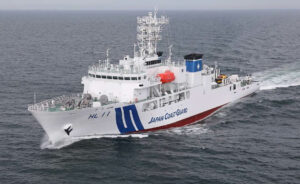
Survey vessel Heiyo, Photo: JCG
For the JCG, operations around the Senkaku Islands have been part of their daily routine for almost ten years now. The fact that the Chinese side regularly deploys CCG units alongside fishing boats in this context certainly gives it a strategic advantage in media coverage. Relatively weakly armed CCG units appear far less martial than regular naval units, but as coast guard units they emphasise the Chinese territorial claim in a striking way. From the JCG's perspective, the fact that the Chinese coastguard has grown dramatically in recent years makes matters worse. While the CCG only had 40 ships with a displacement of more than 1,000 tonnes in 2012, this number more than tripled to 131 in 2020. And the trend is still rising.
Outlook
The open conflict over the Senkaku Islands, as well as possible Chinese claims to other parts of the Ryukyu archipelago, are likely to further increase the importance of the Japanese Coast Guard for the country's security in the future. The JCG will have to co-operate even more closely with the country's regular armed forces, which have expanded their network of bases on the disputed islands in recent years. The two institutions thus open up a broad spectrum of response options for the Japanese government in the event of Chinese aggression.
In any case, the JCG will play a key role in maintaining peace in the region because, as a non-military organisation, it can effectively counteract an escalation of maritime disputes on the ground without giving up territorial claims. As the Japanese coastguard must not lose sight of its traditional tasks and relations with its North Korean and Russian neighbours are likely to continue to create potential for conflict in the future, the expansion of the JCG envisaged by the Japanese government is definitely a step in the right direction.
Prof. Dr Christian Führer is head of the degree programme at the Baden-Württemberg Cooperative State University Mannheim
Christian Führer

